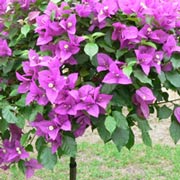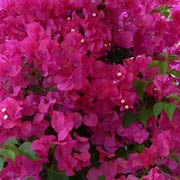Bougainvillea, a brightly coloured climbing plant, thrives in a wide range of climates, from temperate to tropical gardens. Many gardeners have successfully grown them in pots and containers. Keep an eye out for new cultivars, including dwarf, trailing, and standard varieties, which are readily available.
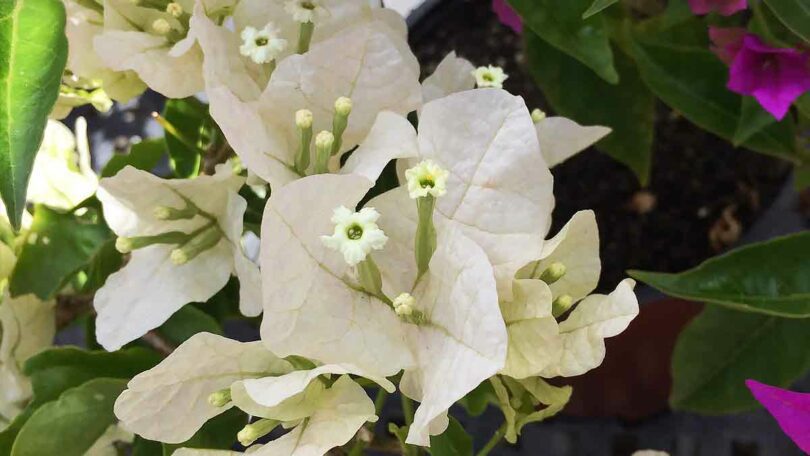
These are natural climbers, and in their native habitat, they often weave through trees with their roots in cool soil, reaching for the sun.
They grow well trained to cover a fence, draped over a pergola or arch, or grown on a pole or column.
The lower-growing varieties can serve as ground covers, form mounds, or even create a semi-formal hedge. Remember that their thorns can be sharp, making them effective natural barriers.
How to grow Bougainvilleas in Your Garden
- Choose the type of Bougainvillea you want to grow.
Climbing, Standard or Dwarf types are all available and this will determine where you plant you Bougainvillea - Choose the location.
Full sun to a little shade is best. They thrive in a bright, sunny spot, but try to provide some shade for their roots by mulching around the base.
Standard and dwarf types can be grown in pots or containers.
The climbing types will need a trellis or some other strong support. - Prepare your soil
You’ll need a humus-rich, moist, and well-drained soil for Bougainvilleas.
Amend soil with compost and some aged cow manure if needed. - Planting Your Bougainvillea
Weed the area well.
Dig a planing hole twice the diameter of the pot and the same depth.
Loosen the soil at the bottom of the planting hole.
Plant at the same depth your Bougainvillia was in th container.
Keep in mind that they don’t like to be disturbed once planted; their roots are quite delicate and can easily break, so take care when planting.
If you’re using pots, use a high-quality potting mix.
Water in well with a liquid seaweed fertiliser.
Mulch around the plant well.
Bougainvilleas can be affected by frost, so it’s advisable to avoid frost-prone areas. In cooler climates, avoid planting them in areas exposed to cold winds, as this can lead to tip burning.
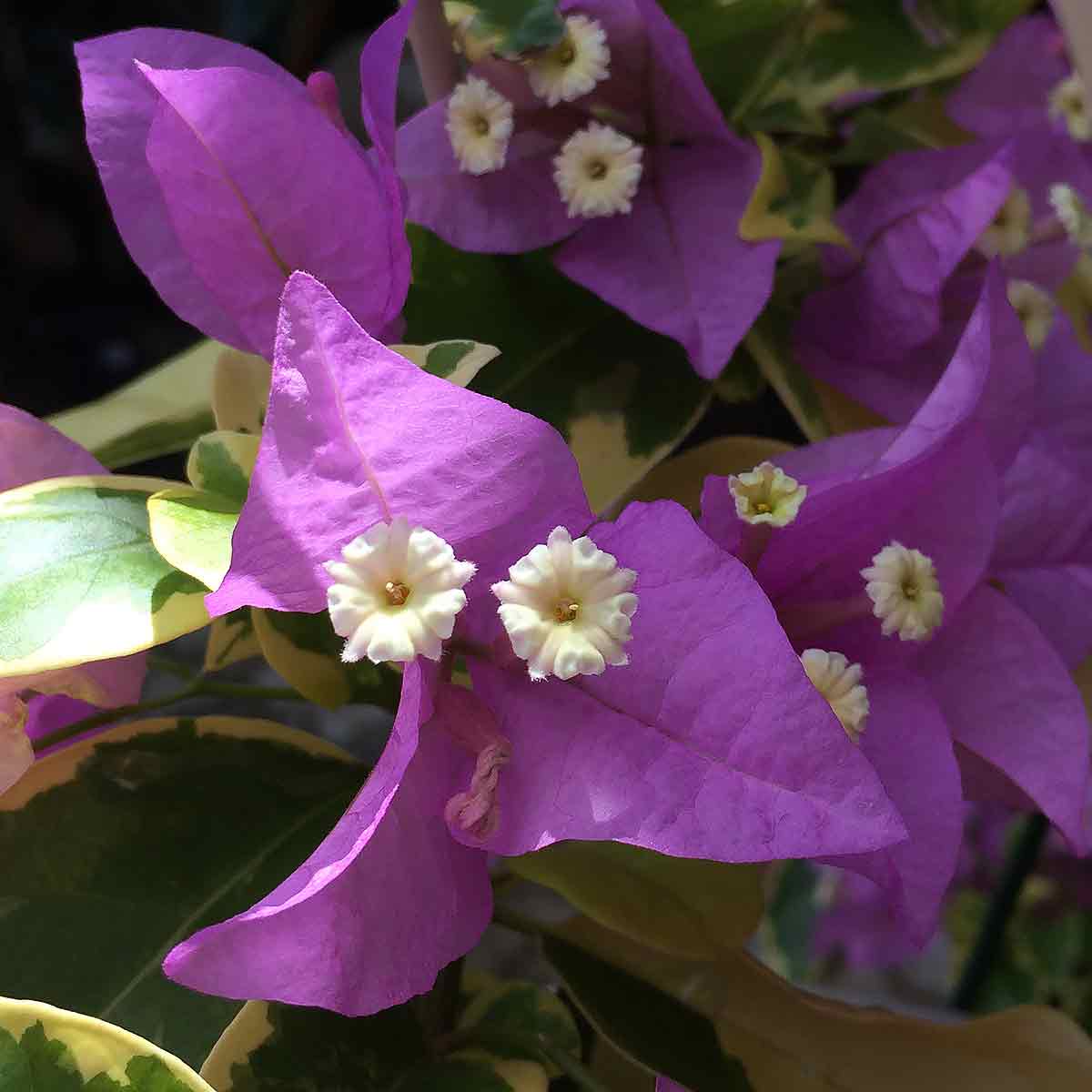
Ongoing Care
Fertiliser For Bougainvillea
Just like most plants, you need to prepare the soil first. , and since Bougainvilleas do not need a lot of fertilizer, a once year application of a high-potash fertilizer is all thats usually required.
Watering Bougainvillea
When it comes to watering, exercise some caution. While these beautiful flowering plants don’t like to dry out completely, their flowering is more prolific during the warmer months when the soil is somewhat dry.
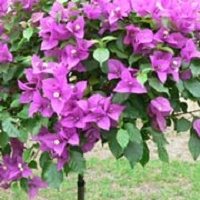
- A well drained soil is essential, water well every 3 weeks, a deep watering is best. Overwatering can cause poor flowering as well as fungal diseases.
- A lack of water is indicated by drooping foliage, dry foliage or leaf lose. A deep watering can quickly restore the plant. Extremely dry soil for extended periods can kill the plant.
Bougainvilleas can also be grown in pots if desired.
For good flowering, plant them in a warm, frost-free location with well-drained yet moist soil.
How To Get Bougainvilleas to produce more flowers.
Bougainvilleas tend to develop less flowers and more thorns when they are growing vigorously.
This can result from over-fertilisation and aggressive pruning. During rapid growth, the flowers that appear on the left axils are replaced by thorns. They also produce less flowers if overwatered.
A lack of flowers is usually due to insufficient sunlight, with the plant needing at least 6 hours of direct sunlight daily (not filtered sunlight) as a minimum for good blooms. Insufficient sunlight encourages more foliage growth.
For More Flowers Try these Tips
- Restrict watering
- Reduce fertilizer
- Grow them in containers, where their root growth is restricted, increasing the likelihood of better flowering.
- Restrict Pruning
- Using a bit of sulphate of potash can help encourage flowering.
Pruning Bougainvilleas
Pruning is important to keep your Bougainvilleas in shape, control their size, or train them as standards. You can prune twice a year as needed.
Sometimes, Bougainvilleas may produce long water shoots, which can be trimmed or removed.
Propagation
Propagation from cuttings is fairly simple.
- Take a 15 cm semi-hardwood cutting.
- Apply rooting hormone powder if desired.
- Pot into normal potting mix.
- Place it in a warm, shaded area with humidity until new growth emerges.
- Keep it consistently moist.
- Before planting it outdoors, allow it to acclimatise and become hardier.
Bougainvillea Varieties
With a multitude of varieties, Bougainvillea flowers come in various colours, from white to deep pink. While they can be trained or pruned into standard plants and grown in containers, they are typically used as climbing plants.
Dwarf Bougainvillea, also known as Bambino Bougainvillea, is the latest addition to the market. These are perfect for pot or large hanging basket cultivation and can also be grown as standards with some selective pruning that is not difficult to do.
You can find other dwarf cultivars that grow to around 60cm. They can be used to create mounds, standards, or even serve as ground cover plants. Some cultivars have a weeping habit and can be used as trailing plants or in hanging baskets. One example is the ‘Klong Fire‘ variety, which is both dwarf and semi-thornless, featuring beautiful red flowers, and it’s available at retail nurseries.
Bougainvillea glabra is a naturally smaller growing species with flower colours ranging from white to purple. It’s long-flowering and a sought-after garden plant. The larger Bougainvillea spectabilis features cream flowers and red to purple bracts. Lastly, Bougainvillea peruviana is more of a scrambling and less dense variety, with crimson flowers ranging from light to dark and offering repeat flowering.
Also, there are hybrids that combine traits from these three types.
It’s important to note that not all dwarf varieties grow the same way. Some may reach around 1 meter, while others can grow up to 3 or 4 meters. This is still much smaller than the larger types, which can easily reach heights of 15 meters or more under favourable conditions.
Is there such a thing as a thornless Bougainvillea?
As its name suggests, Bougainvillea arborea is almost thornless and grows more like a tree. However, currently, this variety is not widely available. On the other hand, the dwarf varieties have significantly smaller thorns.
Summary Information
- Soil – As long as the soil is well drained, these plants are not fussy.
- Position – Best grown in full sun.
- Height – The height they will grow depends on variety – dwarf types from 1 to 2m, larger types to 12m.
- Flowers – Papery flowers in various colours from white through to red, purple and orange. Flowering is reduced in shaded areas.
- Flowering time – Long flowering in warmer climates. In cooler climates, flowering time is spring to summer.
- Leaves – Foliage is alternate, mid green and on thorny stems.
- Pruning – Best time for pruning is after flowering.
You May Also be interested in
- More tropical Garden Plants
- Frangipani
- Clematis
- Mandevilla
- Lapageria
- Climbing roses
- WisteriaWisteria
- Hardenbergia (happy wanderer)Hardenbergia (happy wanderer)
- Pandorea (bower of beauty)Pandorea (bower of beauty)
- Lonicera (honeysuckle)
Bougainvillea varieties are available for sale from the following nurseries
Online and Retail Melbourne and Geelong based garden centres. Check out their large range of indoor and outdoor plants, Australian Natives, Fruit Trees and Edibles, Succulents, Gardenias, Camellias, Hydrangeas plus a full range garden products for delivery in Melbourne.
www.diacos.com.au
451 Lytton Rd, Morningside QLD 4170
Located just 5km East of Brisbane CBD. Selling in volume direct to the public. Focus on top quality both in our plant & pot ranges.
www.rossevansgardencentre.com.au
12 Bains Rd Currumbin Valley QLD 4223
We grow plants and courier them straight to your backyard for free. Bundled up in packs, we have a range of on-trend plants to help you give your garden some serious love. All states except WA and TAS


